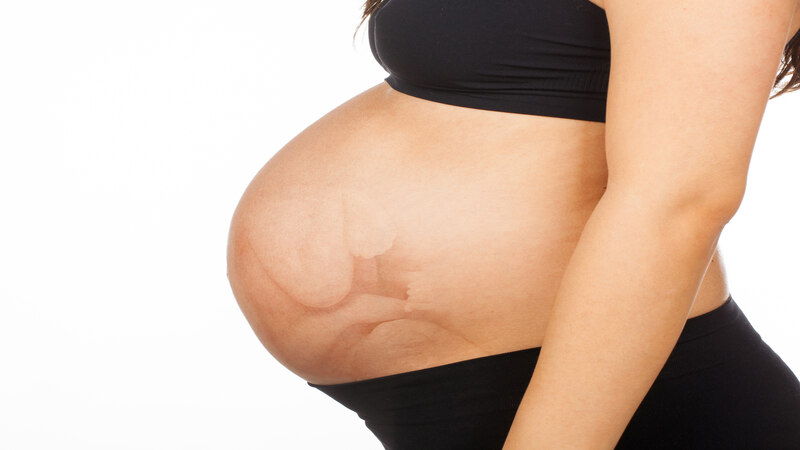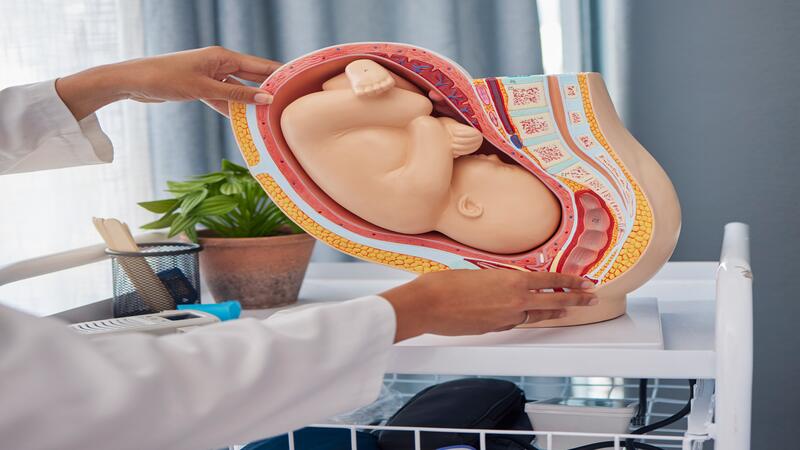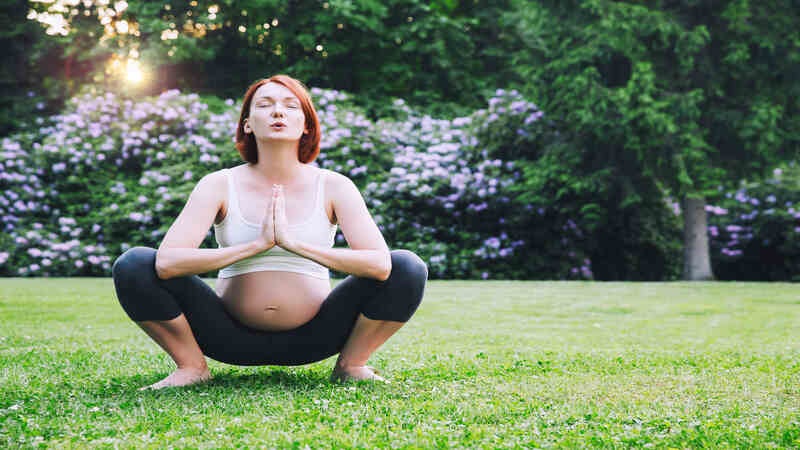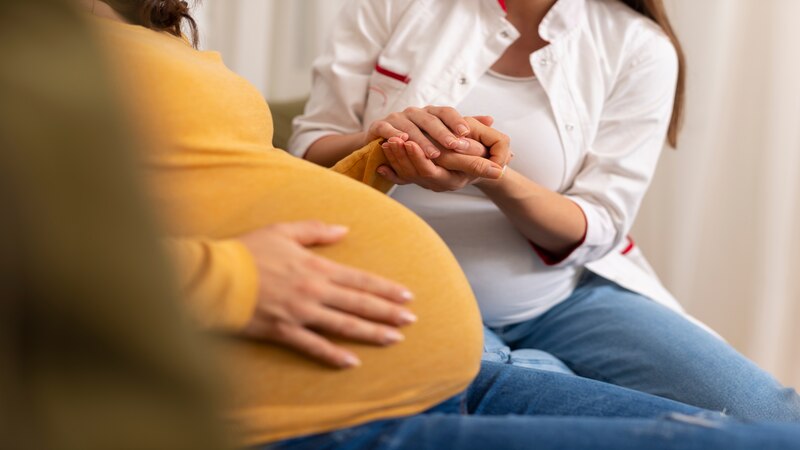
Feeling the baby’s first movements is a magical moment for all pregnant women. Those cute flutters are also a sign that your baby is doing well inside. As the pregnancy progresses, these movements become more prominent and vigorous. This way, the baby tends to change its position from time to time.
Most of the babies settle into a head-down position towards the end of pregnancy, which is the most optimal and safest position for a normal delivery. Continue reading the article to learn more about this position and how you can encourage your baby to adopt it.
What Is the Ideal Position Of A Baby For Delivery?
For safe vaginal delivery, the ideal position of the fetus is the cephalic presentation, where the head of the baby enters the birth canal first [1]. The back of the head should be in front of the mother’s belly. This is called the cephalic or occiput anterior position.
[Read: 6 Different Types Of Delivery Methods]
Advantages of Anterior Position And Why is it Best For Giving Birth?

The occiput anterior position is the safest and most straightforward position of the fetus at the time of birth [2]. Below are the advantages of this position over others:
1. Smooth Passage Through The Birth Canal
When the baby is head down and facing the mother’s back, it ideally aligns with the shape of the birth canal. This ensures an easy descent of the baby through the pelvis during labor.
2. Reduced Complications
When the baby is in the cephalic position, there are fewer chances of complications during labor and delivery. This position also reduces the risk of shoulder dystocia, which happens more frequently with other positions, like breech [3].
3. Short Duration of Labor
As the baby is in the most optimal position for birth, women with babies in cephalic presentation often have shorter labors.
4. Fewer Chances of an Assisted Delivery
There are meager chances of an assisted delivery using forceps or vacuum extraction when a baby is in an occiput anterior position [4].
What is a Back-to-Back (Occipito-Posterior) Position?
A back-to-back or occipital-posterior position is the birth position of the baby where the back of its head (occiput) faces the mother’s spine. It is the most common malpresentation in Labor [5]. This position can contribute to a challenging process of labor and delivery and can even prolong the duration of labor.
Why Are Some Babies Posterior?
Babies naturally tend to move a lot and therefore change positions throughout the pregnancy. A rare few of them settle themselves naturally into a posterior position, with their back against the mother’s back. Many studies believe that it also depends on the shape of the mother’s pelvis [6].
Women who have had several pregnancies in the past have a higher chance of their fetus getting into a posterior position. This can be due to changes in the uterus or pelvis in past deliveries [7].
Lack of physical activity during pregnancy, where the mother spends too much time sitting or lying down, can also contribute towards a posterior position.
Top 8 Exercises To Move Baby Into The Ideal Position For Birth

Staying active throughout your pregnancy can help your fetus stay in an ideal position for birth [8]. After discussing this with your healthcare provider, you can consider the following exercises to help move your baby into an ideal position:
1. Walking
Regular walking, especially during the later part of your pregnancy, can help your baby move into an ideal position [9].
2. Squats
Doing squats near your delivery date or just before labor can help bring the baby into a cephalic position [10].
3. Pelvic Tilts
Performing pelvic tilts while lying on your back with knees bent or on your hands and knees can encourage the fetus to move into an optimal position [11].
4. Cat-Cow Stretches
Simply stretching by arching your back (like a cat) and then lowering your belly and lifting your head up (like a cow) can help get your baby in an ideal position [12].
5. Forward Lunges
Lie down on your side with the support of a pillow. This position releases pressure on your back and encourages your baby to move into an ideal position.
6. Side-lying Release
Lie down on your side with the support of a pillow. This position releases pressure on your back and encourages your baby to move into an ideal position.
7. Forward Leaning Inversions
This exercise helps create room in the lower part of the uterus, which the baby can use to get into an ideal position for birth.
8. Birth Ball
Using an exercise ball helps in releasing pressure from the lower back and in creating room in the pelvis [13].
[Read: Exercises For Normal Delivery]
How Do I Know What Position My Baby Is In?
Generally, a woman gets to know about the position of the baby during the hospital visits. The doctor can determine the position of the baby by palpating the abdomen [14]. This way, they can locate the baby’s head, limbs, and back and assess the position, whether it is cephalic, transverse, or breech.
To confirm this, it is always better to get an ultrasound, as it provides a clearer image of the baby’s position.
Should I Be Worried If My Baby Is Not In The Ideal Position For Birth?

Baby not being in an ideal position nearing the delivery date can be worrisome to a lot of new mothers. However, this situation can be managed well, as a lot of babies change to a cephalic position just before labor.
Several exercises also help encourage the baby to get into an optimal position.
What Will Happen If My Baby Is In An Occipito-Posterior Position During Labor?
Some babies remain in a persistent occipito-posterior position even during labor. This can be quite challenging and can lead to several complications, like
- Prolonged Labor
- More pain and discomfort during labor and delivery.
- Back pain
- Increased chances of an assisted vaginal delivery or cesarean section
Prolongation of labor due to this unfavorable position means higher chances of interventions in a vaginal delivery. The use of forceps or a vacuum might become necessary. If the labor still doesn’t progress, then it calls for a cesarean section.
Most babies eventually settle into an ideal position. Many babies who remain posterior often adjust their position to a safer one before labor. Staying active and stress-free is important during pregnancy. Consult your doctor if you have any concerns regarding the position of your baby.
FAQ’s
1. How Do You Get A Baby In The Best Position For Labor?
Several techniques and exercises can help get the baby into an ideal position for Labor. They include pelvic tilts, exercises with a birth ball, walking, etc. Your healthcare provider will help you make a better plan for managing labor and delivery in this case.
2. How Should I Position My Baby For Normal Delivery?
The most favorable position for a normal delivery is the occiput-anterior where the baby is positioned in such a way that their back faces the mother’s stomach and their chin is tucked into their chest.
3. When Should Baby Get Into Position For Birth?
Generally, the fetus moves into an optimal position for birth in the later part of the third trimester, mostly around 36 weeks.
4. How Do You Get A Baby To Change Position In the Womb?
Certain exercises like walking, pelvic tilts, forward-leaning inversion, etc. help encourage the baby to move to an ideal position for birth. It is always better to consult your healthcare provider before going for these exercises.
Reference
- Cephalic Presentation, Obstetrics, Gynaecology & Reproductive Medicine, 2023 – https://www.sciencedirect.com/topics/medicine-and-dentistry/cephalic-presentation
- Chamberlain G, Steer P. ABC of labor care: unusual presentations and positions and multiple pregnancies – https://pmc.ncbi.nlm.nih.gov/articles/PMC1115589/
- Written by: Birth Injury Justice Center and Reviewed by: Katie Lavender, RN – https://www.childbirthinjuries.com/birth-injury/shoulder-dystocia/causes/
- NHS, Forceps or vacuum delivery – https://www.nhs.uk/pregnancy/labour-and-birth/what-happens/forceps-or-vacuum-delivery/
- Phipps H, Hyett JA, Kuah S, Pardey J, Ludlow J, Bisits A, Park F, Kowalski D, de Vries B. Persistent Occiput Posterior position – OUTcomes following manual rotation (POP-OUT): study protocol for a randomized controlled trial. Trials. 2015 Mar 15;16:96 – https://pmc.ncbi.nlm.nih.gov/articles/PMC4436169/
- The occipitoposterior position, D’Esopo, D.Anthony, American Journal of Obstetrics & Gynecology, Volume 42, Issue 6, 937 – 957 – https://www.ajog.org/article/S0002-9378(41)90261-2/
- Mgaya, A.H., Massawe, S.N., Kidanto, H.L. et al. Grand multiparity: is it still a risk in pregnancy? BMC Pregnancy Childbirth 13, 241 (2013) – https://link.springer.com/article/10.1186/1471-2393-13-241
- Katz M. Physical activity during pregnancy – past and present. Dev Period Med. 2018;22(1):9-13 – https://pmc.ncbi.nlm.nih.gov/articles/PMC8522915/
- NHS, Exercise in pregnancy – https://www.nhs.uk/pregnancy/keeping-well/exercise/
- Nasir A, Korejo R, Noorani KJ. Childbirth in a squatting position. J Pak Med Assoc. 2007 Jan;57(1):19-22 – https://pubmed.ncbi.nlm.nih.gov/17319414/
- Hunter S, Hofmeyr GJ, Kulier R. Hands, and knees posture in late pregnancy or labor for fetal malposition (lateral or posterior). Cochrane Database Syst Rev. 2007 Oct 17;2007(4):CD001063 – https://pmc.ncbi.nlm.nih.gov/articles/PMC8407052/
- Prenatal Yoga Center- https://prenatalyogacenter.com/7-moves-to-prepare-your-pelvis-for-birth/
- Cleveland Clinic, Benefits of Using a Yoga Ball During Pregnancy and Labor – https://health.clevelandclinic.org/birthing-ball
- Shervonne S. Superville; Marco A. Siccardi, Port Of Spain General Hospital, San Paolo Hospital Savona –https://www.ncbi.nlm.nih.gov/books/NBK560814/
